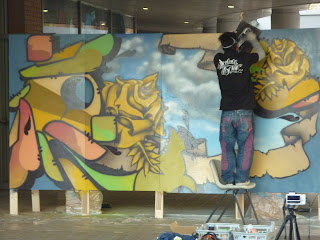This past Saturday I visited Kinkak-Ji—the Golden Pavilion for the first time. I had wanted to visit Kinkaku-Ji since the beginning of the semester, but waited for this time of year so as to see the koyo—autumn leaves change colors. The Kyoto area has numerous famous sites in which to see the koyo and because of its immense popularity, there are many resources to help visitors choose where to visit based upon the best possible time and color change of the leaves. At the train station there were posters that indicated the sites that were almost ready, actively viewable, and no longer viewable—in terms of the autumn colors. Luckily enough, the trees surrounding Kinkaku-Ji were at the peak of their transformation and provided a complimentary beauty to the temple. Having never been to Kinkaku-Ji prior to Saturday’s excursion, I had only briefly studied and read a bit of literature about the temple. Seeing it first hand was a great experience because it helped me to piece together the information I had previously learned with the visual aspect of visiting the temple.
We arrived at the temple at what seemed to be the prime time for visitors during the day. There was such a large number of people that there was a guard stationed at the entrance to facilitate the flow of people that were passing by for a view of the temple from across the water. The weather was perfect and the sun was shining enough to make you squint when gazing at the Golden Temple itself. I wanted to get a few good photos of the temple, but had to jockey my way through the masses of other people who likewise wanted to take pictures. It was really amusing to me that nearly everyone young and old had some type of camera, whether an actual camera or mobile phone camera. The availability of technology such as cameras is so widely spread that anyone can now use visual media as a means to catalogue their lives. While taking photos more often then not, I found that in trying to simply take a photo of the temple or trees, I inadvertently took a photos of other people taking photos.
As we walked away from the lake and the area surrounding the temple, we came to a small pavilion that had coins of all sorts stuck on its thatched roof and the in the small stream that passed beneath it. The purpose of the pavilion is to throw a coin onto the roof and if it does not fall off, it entails that you will have good luck. Being in the spirit of the moment I threw several coins of various value onto the roof before finally succeeding in lodging one on top. There were several of these types of things there, but the pavilion was the first and only one I tried. As we neared the exit to return to the main entrance, I noticed the food and gift venders; one in particular caught my eye—sake with gold flakes.
I have had the opportunity many times to witness the leaves change color in the fall season before coming to Japan, but it was refreshing to see the degree of acknowledgement and the festive attitude that people in Japan give the koyo.





